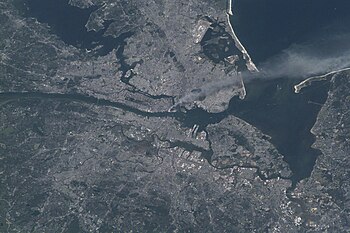
Back الآثار الصحية الناجمة عن هجمات 11 سبتمبر Arabic Efectos de salud derivados de los atentados del 11 de septiembre de 2001 Spanish Gezondheidseffecten van de aanslagen op 11 september 2001 Dutch Vplivi napada 11. septembra 2001 na zdravje Slovenian

Within seconds of the collapse of the World Trade Center in the September 11 attacks, building materials, electronic equipment, and furniture were pulverized and spread over the area of the Financial District of Lower Manhattan. In the five months following the attacks, dust from the pulverized buildings continued to fill the air of the World Trade Center site. Many New York residents have reported symptoms of Ground Zero respiratory illnesses.[1]
Various health programs have arisen to deal with the ongoing health effects of the September 11 attacks. The World Trade Center Health Program, which provides testing and treatment to 9/11 responders and survivors, consolidated many of these after the James Zadroga 9/11 Health and Compensation Act became law in January 2011.[2]
More people have died from illnesses caused by 9/11 than during the attack itself.[3][4]
- ^ Barry, Ellen (October 14, 2006). "Lost in the Dust of 9/11". Los Angeles Times. Retrieved May 4, 2010.
- ^ "World Trade Center Health Program FAQ". Centers for Disease Control and Prevention. Retrieved July 2, 2012.
- ^ "More people have now died from 9/11 illnesses than during the attacks". September 12, 2021. Retrieved February 8, 2023.
- ^ "More People Died of 9/11-Related Illnesses Than in the Initial Attack". Newsweek. September 7, 2021. Retrieved February 8, 2023.
© MMXXIII Rich X Search. We shall prevail. All rights reserved. Rich X Search